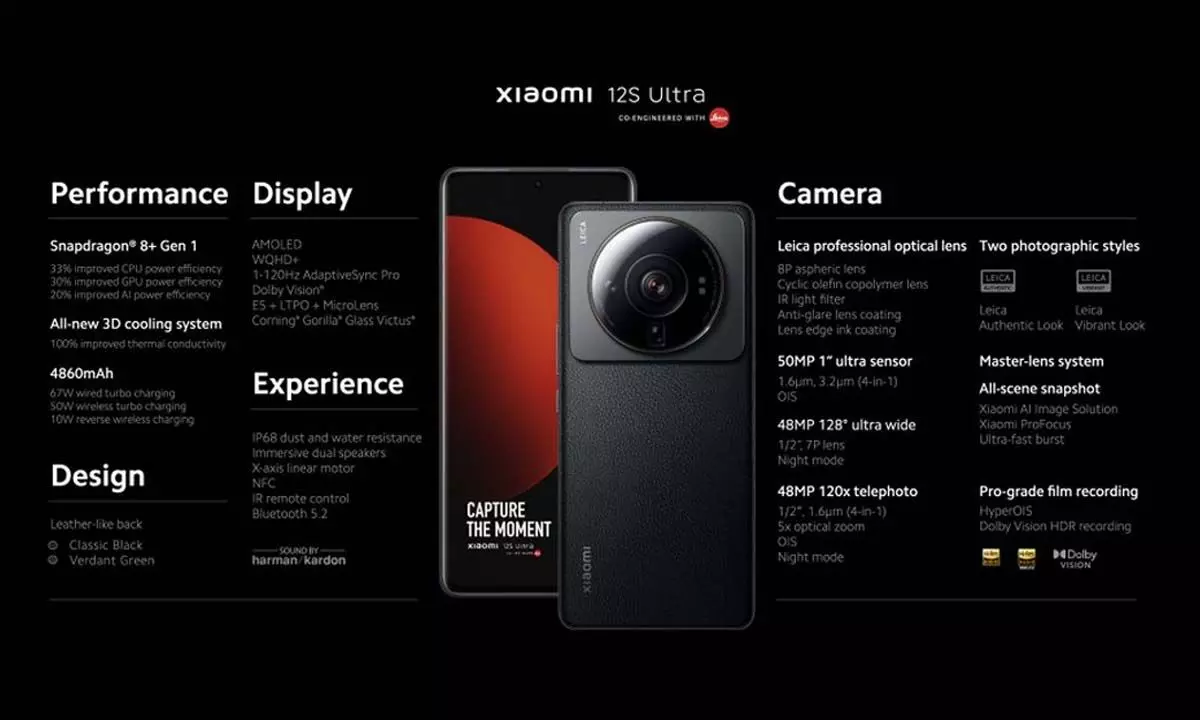Xiaomi 12S Ultra offers the world's biggest smartphone camera

Xiaomi 12S Ultra offers the world's biggest smartphone camera
Xiaomi 12S Ultra boasts the world's largest smartphone sensor: a 50-megapixel 1-inch sensor behind a 23mm f/1.9 Leica lens.
Xiaomi has announced its 12S Series, including the Ultra co-designed with Leica. That flagship boasts the world's largest smartphone sensor: a 50-megapixel 1-inch sensor behind a 23mm f/1.9 Leica lens.
The Xiaomi 12S Ultra features a 6.73-inch AMOLED display that promises 1,500 nits of peak brightness at 2K resolution with support for the P3 colour gamut (no details on actual colour accuracy provided). Behind the screen, the Xiaomi 12S Ultra is the first flagship model to be equipped with two proprietary Xiaomi Surge chips, the Xiaomi Surge P1 fast charging chipset and the Xiaomi Surge G1 battery management chipset offers significant improvements in battery management and general user experience.
The new smartphone also supports 67W wired fast charging, 50W wireless fast charging and 10W reverse wireless charging. A silicon-oxygen anode battery is at the core of the Xiaomi Surge battery management system. A single 4860mAh cell and a Xiaomi Surge P1 fast charging chipset, which the company says also supports up to 16A output current with a conversion efficiency of 96.8%. Not to downplay better battery and screen size, but the show's real star is the giant camera array.
The Massive Camera
The massive camera on the back of the Xiaomi 12S Ultra is centred around a 1-inch Sony IMX989 sensor that uses a Quad-Bayer pixel array with individual 1.6μm pixels. After pixel binning, Xiaomi says these pixels become 3.2μm larger, which reduces noise, expands the dynamic range, increases captured light, and achieves better images overall in low-light conditions. The sensor was co-developed between Sony and Xiaomi, and Engadget reportedly includes a 50-50 split to bear the costs of putting it together.
To use the full 1-inch sensor size, Xiaomi leaned on Leica to develop a "sophisticated optical lens." The company says: "[The 12S Ultra] utilizes Leica's world-class optical design capabilities in its lens system while adhering to their stringent optical quality testing standards and implementing Xiaomi's expertise in miniaturizing components to ensure ultra-high resolution, ultra-high light sensitivity, reduced dispersion, and lower flare."
The lens supposedly mitigates flare, ghosting, and chromatic aberration. In addition to the lens's physical design, the camera has also been fine-tuned to reproduce the tone and aesthetics of Leica with "state-of-the-art algorithms", realized in the Leica Authentic Look and Leica Vibrant Look photographic profiles. The primary camera is also the first Android device to support Dolby Vision HDR video recording and playback. Additionally, it features Xiaomi's HyberOIS image stabilization which the company claims provides ultra-stable performance and continuous motion compensation during video recording.
Xiaomi says the 12S Ultra has also been designed to be friendlier to photographers in post-production, capturing photos in 10-bit RAW format calibrated by Adobe Labs with colour correction metadata embedded directly in the files. When using Adobe Lightroom to open pictures taken on the Xiaomi 12S series, the Adobe Camera RAW software will automatically optimize the photos based on the metadata. Xiaomi says it gives professional photographers a good starting point for post-production.
Xiaomi hinted at launching the landmark smartphone camera last week. Still, the sheer size of the camera array on the back of the new 12S Ultra shows how challenging it is to utilize a large 1-inch sensor in a smartphone design fully. So thin Sony tried something similar with its Xperia Pro-I earlier this year, but due to size limitations, it couldn't use the full size of the sensor like Xiaomi could here. The Xiaomi 12S Ultra smartphone has a starting price of 5,999 yuan, equivalent to about $892. This and the other 12S series smartphones will launch in mainland China first, and the company has not provided any information on when to expect it in other regions.


















